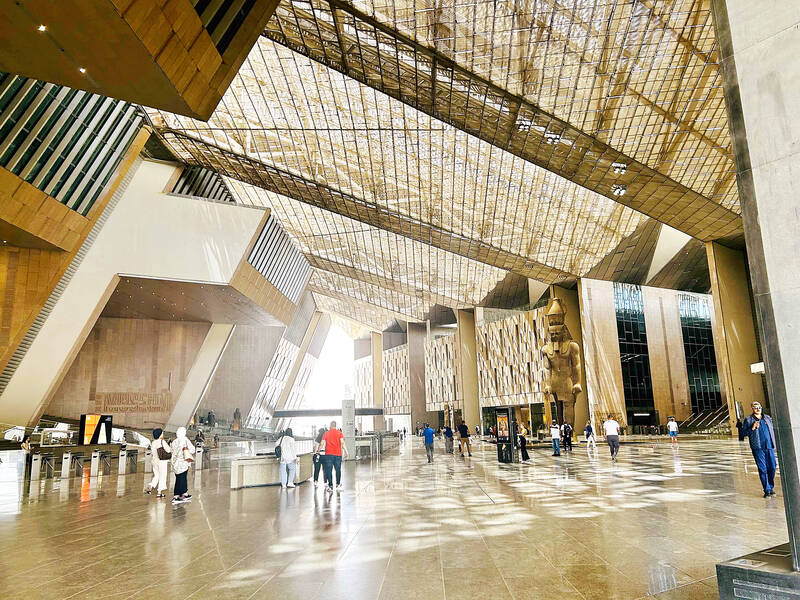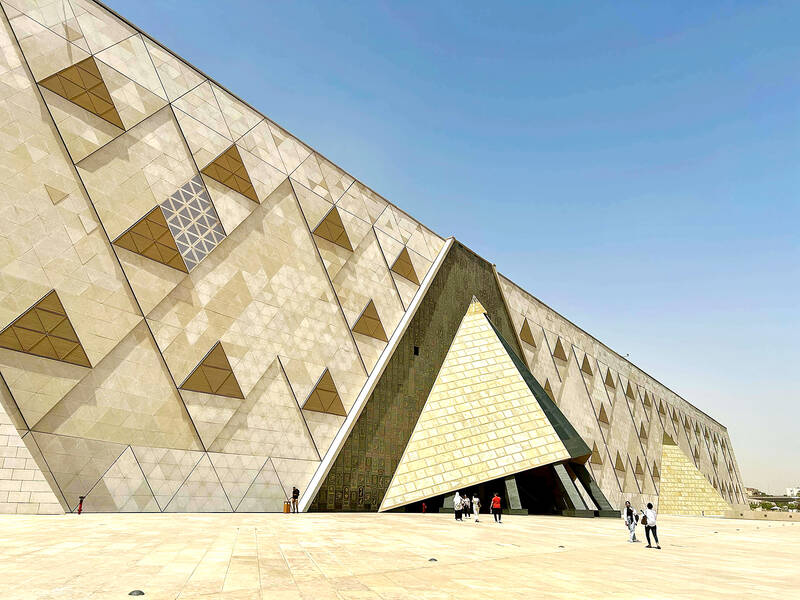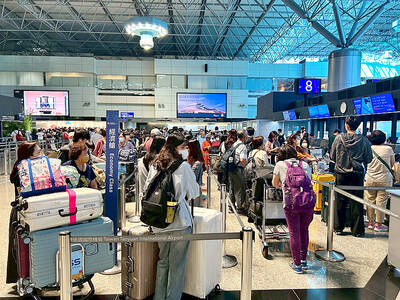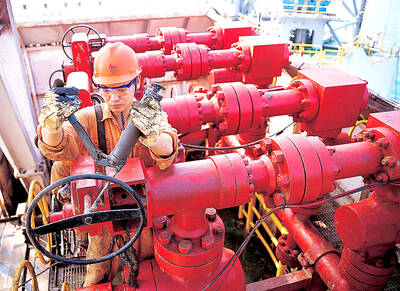After years of delay, the Grand Egyptian Museum in Cairo was unveiled in a limited soft opening on Wednesday last week, finally giving people a peek at the design concept of Taiwanese-American architect Peng Shih-fu (彭士佛) and his wife, Roisin Heneghan.
Initially scheduled to be completed by 2013, what is expected to be the world’s largest archeology museum faced countless delays, primarily due to environmental, financial and political hurdles.
The design that allows visitors to experience ancient Egyptian values was conceived more than 20 years ago.

Photo: CNA
The design was finalized in 2003, when plans from Irish firm Heneghan Peng Architects was chosen out of 1,557 submissions from 82 nations in what was documented as the second-largest architectural competition in modern history.
The Irish company was founded by Peng, a Taiwanese immigrant to the US, and his wife, Heneghan, from Ireland.
Based on the architecture firm’s design, the museum sits squarely between the Giza Plateau and the Nile Valley Plain in what Peng said was an intentional choice he made in reflection of ancient Egypt’s concept of life and death.

Photo: CNA
According to the architect, only his firm among the 1,557 entrants in the competition, which was launched in January 2002, proposed to build the museum between the plateau and the plain to embrace the beauty of life and death, as well as the unique geography of the locations.
The other competitors recommended that it be erected either on the plateau or on the plain, he said.
“Architecture needs to respect the environment,” Peng said in an interview. “The design concept is presented in two parts through the main construction of the architecture and its surrounding landscape. The main body of the museum reflects the past, while the outdoor scenic area presents the rich lives of modern-day humans.”
“The entire compound blends together the interior and exterior; the past and the present; death and life,” he added.
While designing the museum, he did a lot of research on ancient Egypt, its culture, and the relationship between its heritage architectures and the civilization’s geography, Peng said.
“It is because of this geographical location that Egypt was able to embark on a 5,000-year journey through history,” he said.
Ancient Egyptians saw the sun rising in the east as a metaphor for birth and the sunset in the west as a symbol of death, which is why ancient temples were historically built on the eastern bank of the Nile, while the monuments for deceased pharaohs were traditionally erected on the western bank.
In honor of the cultural concept, Peng and his firm have visitors enter the museum from the proximity of the Nile Valley Plain and gradually move in a westward direction toward the Giza Plateau.
Moving from the fertile east to the royal tombs of the west, visitors will experience the crossroads that is life and death, Peng said, adding that a design that can showcase geographical uniqueness and local history is pivotal to a museum.
In the soft opening, up to 4,000 pre-registered visitors a day are given private tours of the museum’s commercial area, exterior gardens, Grand Hall, Grand Staircase and main galleries.
The flagship exhibit, the Tutankhamun Galleries, as well as its Children’s Museum and Khufu’s Boat Museum, remain closed to the public.
Once the museum officially opens, which could happen before the end of this year, more than 100,000 artifacts from ancient Egyptian dynasties are to be displayed over the museum’s 81,011m2 of floor space.
The most popular gallery is likely be the complete King Tut collection that consists of about 5,000 pieces, many of which are to be revealed to the world for the first time since the first items were unearthed in 1922.

The Chinese military has built landing bridge ships designed to expand its amphibious options for a potential assault on Taiwan, but their combat effectiveness is limited due to their high vulnerability, a defense expert said in an analysis published on Monday. Shen Ming-shih (沈明室), a research fellow at the Institute for National Defense and Security Research, said that the deployment of such vessels as part of the Chinese People’s Liberation Army (PLA) Navy’s East Sea Fleet signals a strong focus on Taiwan. However, the ships are highly vulnerable to precision strikes, which means they could be destroyed before they achieve their intended

About 4.2 million tourist arrivals were recorded in the first half of this year, a 10 percent increase from the same period last year, the Tourism Administration said yesterday. The growth continues to be consistent, with the fourth quarter of this year expected to be the peak in Taiwan, the agency said, adding that it plans to promote Taiwan overseas via partnerships and major events. From January to June, 9.14 million international departures were recorded from Taiwan, an 11 percent increase from the same period last year, with 3.3 million headed for Japan, 1.52 million for China and 832,962 to South Korea,

SOVEREIGNTY: The rigs show that Beijing ‘rejects Taiwan’s jurisdiction’ by building in areas where Taipei demands permission to build or alter installations Chinese oil rigs have been sighted just 26 nautical miles (42km), from Taiwan’s exclusive economic zone (EEZ) near Pratas Island (Dongsha Island, 東沙島), posing a threat to Taiwan’s sovereignty if left unchallenged, a brief published by the Jamestown Foundation on Tuesday said. Pratas Island, 444km from Kaohsiung, is northeast of the South China Sea and houses a Taiwanese garrison. The brief, titled “Rigging the Game: PRC Oil Structures Encroach on Taiwan’s Pratas Island” — referring to the People’s Republic of China — analyzed photographs and said that Beijing’s tools to pressure Taiwan now include oil rigs. “Oil rigs now constitute part of Beijing’s

The Taiwan Experience Education Program (TEEP) has funded short-term internships in Taiwan for more than 4,500 young people from more than 40 countries since 2015, with the goal of attracting and retaining international talent, the Ministry of Education said yesterday. Fifty-five colleges launched 514 projects this year, including in fields such as semiconductors, artificial intelligence, medicine and biotechnology, green energy, and sustainability, it said. The program provides research and practical internships in Taiwan for two to six months, and offers cultural exchange and networking opportunities, the ministry said. For example, National Formosa University’s Embedded System and Autopilot Laboratory developed two solar-powered drones in